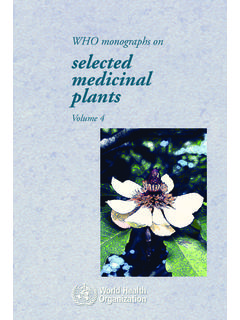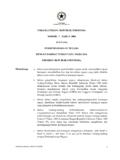Transcription of WHO monographs on medicinal plants commonly …
1 WHO monographs on medicinal plants commonly used in the Newly Independent States (NIS). WHO. monographs on medicinal plants commonly used in the Newly Independent States (NIS). i 14:35. WHO Library Cataloguing-in-Publication Data WHO monographs on medicinal plants commonly used in the Newly Independent States (NIS). , medicinal . , Traditional. of Independent States. I. World Health Organization. ISBN 978 92 4 159772 2 (NLM classification: QV 766). World Health Organization 2010. All rights reserved. Publications of the World Health Organization can be obtained from WHO Press, World Health Organization, 20 Avenue Appia, 1211 Geneva 27, Switzerland (tel.)
2 : +41 22 791 3264;. fax: +41 22 791 4857; e-mail: Requests for permission to reproduce or translate WHO. publications whether for sale or for noncommercial distribution should be addressed to WHO Press, at the above address (fax: +41 22 791 4806; e-mail: The designations employed and the presentation of the material in this publication do not imply the expression of any opinion whatsoever on the part of the World Health Organization concerning the legal status of any country, territory, city or area or of its authorities, or concerning the delimitation of its frontiers or boundaries.)
3 Dotted lines on maps represent approximate border lines for which there may not yet be full agreement. The mention of specific companies or of certain manufacturers' products does not imply that they are endorsed or recommended by the World Health Organization in preference to others of a similar nature that are not mentioned. Errors and omissions excepted, the names of proprietary products are distinguished by initial capital letters. All reasonable precautions have been taken by the World Health Organization to verify the information contained in this publication.
4 However, the published material is being distributed without warranty of any kind, either expressed or implied. The responsibility for the interpretation and use of the material lies with the reader. In no event shall the World Health Organization be liable for damages arising from its use. Printed in France ii 14:35. Contents Acknowledgements v Introduction 1. General technical notices 5. monographs (in alphabetical order of plant name). Bulbus Allii Sativi 9. Radix Althaeae 29. Herba Bidentis 37. Flos Calendulae 49. Flos Chamomillae 61.
5 Herba Chelidonii 73. Folium cum Flore Crataegi 91. Herba Equiseti 113. Fructus Foeniculi 127. Radix Ginseng 141. Radix Glycyrrhizae 161. Flos Helichrysi arenarii 175. Fructus Hippopha s recens 187. Herba Hyperici 201. Herba Leonuri 229. Folium Melissae 241. Aetheroleum Menthae Piperitae 251. Folium Menthae Piperitae 263. Herba Millefolii 271. Herba Origani 285. Herba Pegani harmalae 299. Folium Plantaginis majoris 313. Herba Polygoni avicularis 329. Folium Salviae 343. Folium Sennae 363. Radix cum Herba Taraxaci 373. iii iii 14:35. Contents Herba Thymi 383.
6 Flos Tiliae 393. Radix Urticae 407. Styli cum stigmatis Zeae maydis 423. Annex Participants in the WHO Consultation on medicinal plants commonly Used in NIS, WHO Headquarters, Geneva, 5 7 July, 2006 439. iv iv 14:35. Acknowledgements Special acknowledgement is due to Professor Elmira Amroyan of the Sci- entific Centre of Drug and Medical Technology Expertise, Yerevan, Ar- menia, and Dr Ain Raal of the Institute of Pharmacy, University of Tartu, Estonia, for drafting and revising the monographs . The photograph for the front cover was also kindly provided by Dr Raal.
7 Similarly, special acknowledgement is due to Dr Raymond Boudet-Dalbin of the Labora- toire de Chimie Th rapeutique, University of Paris, France, for drawing the chemical structures. WHO also acknowledges with thanks the valuable work of the ap- proximately 120 experts in more than 60 countries who provided com- ments and advice on the draft texts; those who submitted comments through the World Self-Medication Industry (a nongovernmental organi- zation in official relations with WHO); and those who participated in the WHO Consultation on medicinal plants commonly Used in NIS held in WHO Headquarters, Geneva, Switzerland, in July 2006, to review the monographs (see Annex).
8 Sincere appreciation is extended to the Nippon Foundation, Japan, which provided funds for the development and publication of this volume. Finally, WHO wishes to express thanks to Dr Annet Zakaryan, Ann Arbor, USA, for her indispensable assistance in finalizing and editing the manuscripts. v v 14:35. vi 14:35. Introduction Background The results from the recent WHO/TRM Global Survey on National Pol- icy on Traditional and Complementary/Alternative Medicine and on Regulation of Herbal Medicines in 2003 show that the European herbal medicines market is growing steadily.
9 For example, between 1999 and 2001, herbal medicines sales increased by 22% in the Czech Republic, doubled in Turkmenistan, and increased by 170% in Bulgaria. Currently, the European market is considered to be the world's largest single commercial market for medicinal plants and herbal medicines. Eu- ropean countries are not just importers, but also producers of a large va- riety of medicinal plants and herbal medicines. European consumers, for example, in France, Germany, Italy, Sweden, Switzerland and the UK of- ten use herbal medicines to complement treatment with conventional medicines.
10 In the Newly Independent States (NIS) and Countries of Central and Eastern Europe (CCEE), consumers likewise often favour herbal prod- ucts, but for a different reason. Difficult economic conditions often limit access to the rather expensive conventional medicines that are available, with the result that they seek out less expensive alternative medicines such as herbal products. Many European Union countries already have well-established na- tional policies and programmes for regulating and monitoring herbal medicines. Many NIS and CCEE Member States are now similarly striv- ing to develop and implement national policies and programmes to regu- late herbal medicines.














